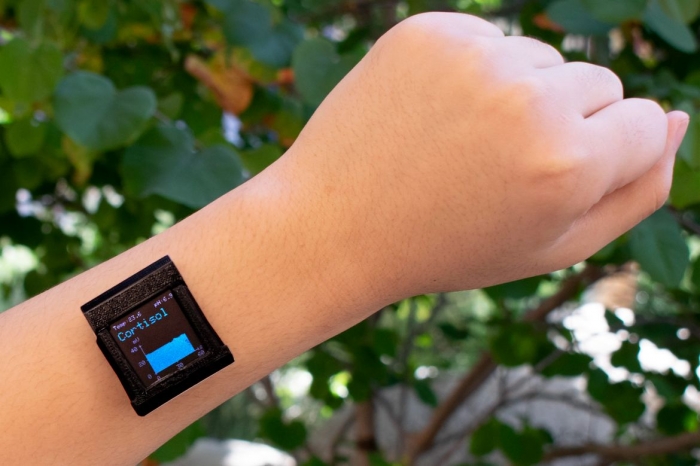 (Image credit: Yichao Zhao and Zhaoqing Wang/UCLA)
(Image credit: Yichao Zhao and Zhaoqing Wang/UCLA)
- Written by William D Snow
Sweating the small stuff: Smartwatch developed at UCLA measures key stress hormone
A UCLA research team has developed a device that could be a major step forward: a smartwatch that assesses cortisol levels found in sweat — accurately, noninvasively and in real time. Described in a study published in Science Advances, the technology could offer wearers the ability to read and react to an essential biochemical indicator of stress.This device opens new possibilities for personal health monitoring.
The human body responds to stress, from the everyday to the extreme, by producing a hormone called cortisol. To date, it has been impractical to measure cortisol as a way to potentially identify conditions such as depression and post-traumatic stress, in which levels of the hormone are elevated. Cortisol levels traditionally have been evaluated through blood samples by professional labs, and while those measurements can be useful for diagnosing certain diseases, they fail to capture changes in cortisol levels over time. Now, a UCLA research team has developed a device that could be a major step forward: a smartwatch that assesses cortisol levels found in sweat — accurately, noninvasively and in real time. Described in a study published in Science Advances, the technology could offer wearers the ability to read and react to an essential biochemical indicator of stress.
“We determined that by tracking cortisol in sweat, we would be able to monitor such changes in a wearable format, as we have shown before for other small molecules such as metabolites and pharmaceuticals,” he said. “Because of its small molecular size, cortisol diffuses in sweat with concentration levels that closely reflect its circulating levels. We’re entering the era of point-of-person monitoring, where instead of going to a doctor to get checked out, the doctor is basically always with us. “The data are collected, analyzed and provided right on the body, giving us real-time feedback to improve our health and well-being.”
The research results are published in this article.
Read the full article at UCLA News.
The technology is available on this UCLA TDG TechnologyPublisher page.
Visible Legacy Comment
The technology capitalizes on previous advances in wearable bioelectronics and biosensing transistors made by Dr. Emaminejad, Dr. Andrews and their research teams, showing the impact of earlier NSF and NIH grants. Newer technologies such as that linked above show promise for Continuous Minimally-Invasive Biomonitoring. I would recommend interested Tech Scouts to explore the Labs and investigators in this ecosystem!
Additional Info
-
Navigator:
 Explore the map in Navigator
Explore the map in Navigator - Widget:
- Caption: Paper: Wearable aptamer-field-effect transistor sensing system for noninvasive cortisol monitoring
Related items
- Federal funding will help WSU professor develop technology to recover rare earth elements
- Unlocking the brain: Peptide-guided nanoparticles deliver mRNA to neurons
- Scientists Get to the Bottom of COVID’s Worst Pediatric Complication
- WSU-inspired national gene-editing task force begins work
- Multi-Tasking Wearable Continuously Monitors Glucose, Alcohol, and Lactate
